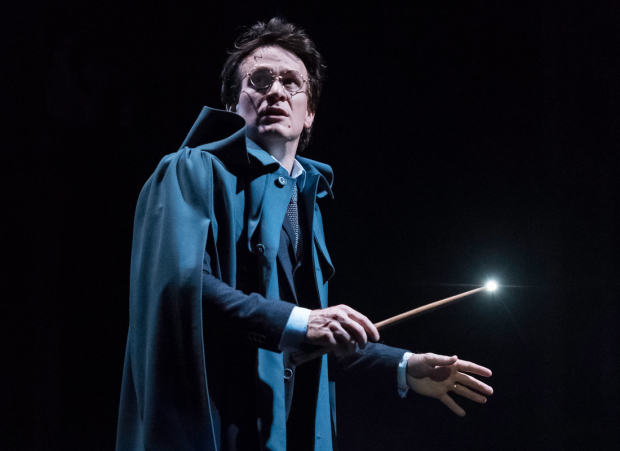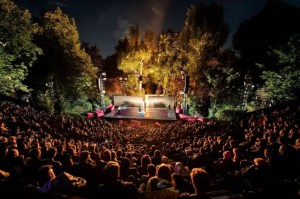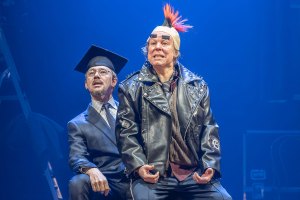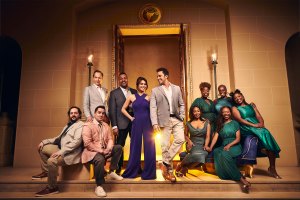Review: Harry Potter and the Cursed Child (Palace Theatre)
JK Rowling, John Tiffany and Jack Thorne’s eighth Harry Potter story is a triumph

© Manuel Harlan
There has been such anticipation surrounding the return of Harry Potter, in new theatrical form, that I felt it was my critical duty to fight the hype. My resolve lasted all the way through the swift-moving opening scenes, when we meet Harry and his friends, now in their forties, and seeing their children off to school. It stayed in place when Ron Weasley, the eternal joker, made Lily Potter Jnr’s nose vanish into thin air and even – much later – when Harry went to work at the Ministry of Magic and literally disappeared in front of my eyes.
I resisted the fluent swing and flow of the staging, which creates the entire world of Hogwarts out of a few banners and two moving library staircases and the lively suppleness of a script full of good jokes and swift insight. I was even unmoved by a sweet that makes smoke come out of a character’s ears and duelling practice with sparkling wands.
But then Harry’s son Albus and his new friend Scorpius Malfoy find themselves on top of the Hogwarts Express, a train built on stage by piles of suitcases, yet whose movement and sway is perfectly conjured by a spinning revolve and wisps of mist. While they whirr into the night, a witch pursues them. As she prowls towards them, long fingers growing threateningly from her sleeve, the chip of ice in my heart melted and I gave in.
This may be the surest commercial proposition for years, but it is also a spectacle of epic sweep and magisterial grandeur. It is, quite simply, magic.
The plot was built by JK Rowling, author of the seven Harry Potter novels, in collaboration with the writer Jack Thorne and director John Tiffany. It is a byzantine confection which – fortunately for those who wish to continue to #KeepTheSecrets – defies any attempt to explain it in 500 words. But it allows The Cursed Child to have its cake and eat it, by simultaneously turning back time to allow characters from the past to reappear, and pushing on into a new story based around Albus (Sam Clemmett), Harry’s second child, and a "disappointing son" who feels he is failing his famous father. His best friend is Scorpius (Anthony Boyle) who is in turn defying his own fate by turning out to be a nice member of the Malfoy clan, "the family you can rely on to make the world a murkier place".
It is a deeply theatrical experience, a love letter to theatre itself
The script, by Thorne, is both sharp and masterfully structured, holding its shape over a narrative arc that lasts through two plays of more than five and a half hours in total. Using a time travel device that both JB Priestley and Steven Moffat would be proud of, it shows how small actions can have huge consequences – and imagines a world where everything has turned out differently. But it sets this huge story (of such delight to the Potterheads in the audience that they ooh and aah when certain things are revealed), against a constant, subtle examination of themes of love, of fathers and children, of loneliness and loss, of the consolations of friendship.
"There’s never a perfect answer in this messy, mixed up world," Harry is told in the second play. The key is how you cope with it.
Thorne’s writing is leavened not only with emotion, but also with great humour. In one stand-out scene Albus, Scorpius and their new friend Delphy (Esther Smith) are transformed into Harry, Ron and Hermione. Ron’s subsequent suggestion to Hermione that they have another baby – "or a holiday" – and her reaction, are an absolute joy.
That scene also reveals Tiffany’s genius at using the tricks of the stage (the sleight of hand of entrances and exits) to make The Cursed Child a deeply theatrical experience, a love letter to theatre itself. It is full of literal magic (illusions created by Jamie Harrison): people fly, vanish and alter in front of your eyes; duels are fought with flashing light; a creature emerges from the darkness, shaped in fire. But thanks to choreographer Steven Hoggett and every single member of the creative and design team, the stage itself becomes a place of teeming fantasy, where a giant can materialise and a mystical beast saunter on from the wings. This pure delight in the sense of what is possible and the imaginative force of its realisation, makes this eighth story in the Harry Potter series a very particular experience.
People fly, vanish and alter in front of your eyes
What you would make of it all if you didn’t know anything about Harry Potter, I can’t quite imagine. But I think you would find moments that simply take your breath away; one, which concludes the first play, is simultaneously so beautiful and so terrifying that it would be a crime to spoil.
In so grand a display, it would have been easy to neglect the performances. Yet they are uniformly good and occasionally outstanding. As Harry, Jamie Parker has just enough boyish charm alongside his adult grief and it is lovely to watch Poppy Miller develop the character of Ginny, now sports editor of the Daily Prophet. Ron, in Paul Thornley‘s genial grip, is both a source of comic relief from tension and a font of truth. His scenes with Noma Dumezweni‘s ardent, clever Hermione quite often made me want to cry; she illuminates each moment she is on stage. And Boyle gives a career-making performance as Scorpius, turning him into an Eeyorish figure of deep pessimism and profound bravery.
As you can see, I loved it. I could go on writing about it. It is a triumph.
Harry Potter and the Cursed Child runs at the Palace Theatre until May 2017.














